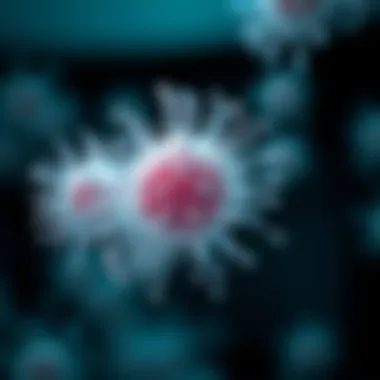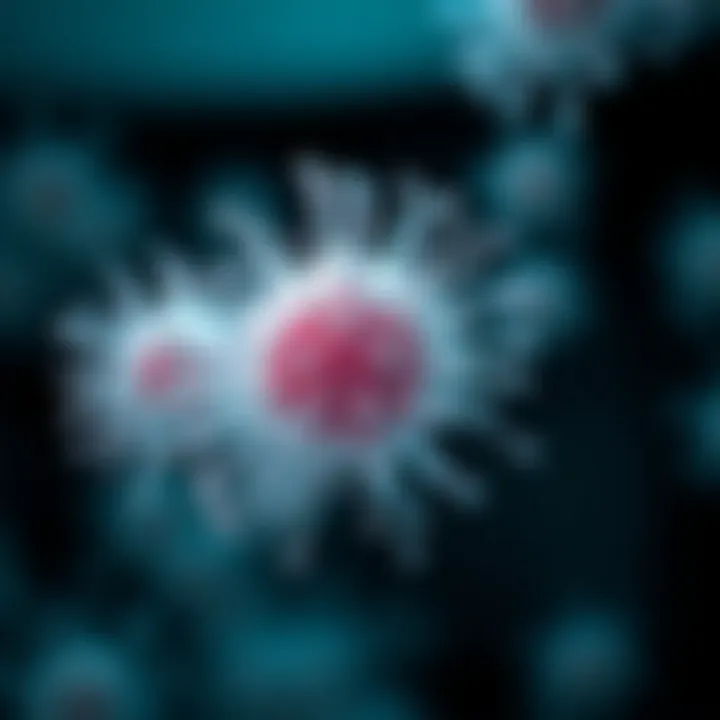Ramos Cells: Characteristics and Research Applications


Intro
Ramos cells have carved out a significant niche within the realm of biological research, particularly in immunology. This article aims to dissect the illustrious history, unique traits, and diverse applications of Ramos cells. With thorough examination and thoughtful analysis, readers will not only gain a comprehensive understanding of the subject but also appreciate the role these cells play in advancing scientific knowledge. Let's embark on this exploration, paying special attention to their origin, characteristics, and various applications in research and therapeutic development.
Research Background
Overview of the scientific problem addressed
In the ever-evolving landscape of cellular biology, researchers require specific cell lines that can serve as reliable models for various studies. Ramos cells, derived from a Burkitt's lymphoma patient, present a valuable resource for investigating both normal and aberrant immune responses. The scientific community thrums with interest regarding how these cells can elucidate the mechanisms of lymphocyte development and function, as well as aid in understanding the underlying pathology of certain cancers.
Historical context and previous studies
Ramos cells have been around since the late 1960s when they were first established. Since then, a multitude of studies have leveraged this cell line to uncover significant insights into cell signaling, proliferation, and apoptosis within the lymphoid system. Early investigations highlighted their capacity to produce antibodies, making them a preferred model in B-cell research. For instance, work conducted by researchers like Hsu and colleagues has provided foundational insights into the interactions of Ramos cells and various signaling pathways.
Findings and Discussion
Key results of the research
Recent advancements in technology have allowed researchers to explore Ramos cells in novel ways. For instance, studies focusing on the cell line's response to different immunotherapies have shown promising results. Furthermore, their utility in the production of monoclonal antibodies opens the door for targeted therapies, which are a hot topic in cancer treatment. Numerous investigations reveal the mechanistic pathways influencing the immune response, providing valuable data that researchers can use to develop better therapeutic strategies.
Interpretation of the findings
The salient findings surrounding Ramos cells underscore their adaptability and use in various environments. They not only serve as a model for understanding B-cell behavior in health and disease but also offer insights into potential therapeutic applications. As researchers dissect the layers of how these cells operate, they often discover links to systemic immunity, further enhancing our understanding of immune mechanisms at a cellular level.
"Ramos cells stand as a pillar in the innovative studies of immunological phenomena, making significant contributions to both research and practical applications."
Prologue to Ramos Cells
Ramos cells hold a pivotal position in the landscape of cellular biology and immunology. This cell line, derived from a human B lymphocyte, brings a significant legacy from its inception, which began in the early 1980s. Their study has been vital in unraveling intricate mechanisms of immune responses and has far-reaching implications in therapeutic developments. For researchers, educators, and students alike, understanding Ramos cells is like holding a key that opens doors to broader inquiries about B cell functionality and pathology.
Historical Background
The origins of Ramos cells trace back to a patient diagnosed with Burkitt’s lymphoma, a type of cancer that aggressively targets B cells. This particular cell line was named after the researcher who isolated it, Dr. David Ramos, and was eventually deposited at the American Type Culture Collection (ATCC) in 1985. Their availability for research has sparked numerous studies, reflecting how a single cell line can pivot the trajectory of scientific discovery.
Ramos cells exhibit distinct immunophenotypic characteristics, which include surface markers such as CD19, CD20, and immunoglobulin receptors. These traits not only enable easier identification and study but also provide foundations for various experimental designs. As investigations continue into their lineage and potential modifications, the historical significance of Ramos cells remains a cornerstone in understanding B-cell-related disorders.
Significance in Biological Research
Ramos cells are of paramount importance in biological research, particularly within the realms of immunology and oncology. The ability to manipulate these cells makes them ideal candidates for various experimental setups, such as evaluating drug efficacy and understanding immune mechanisms. Ramos cells enable scientists to dive deep into research about antibody production and further explore the pathways that lead to B cell malignancies.
"By studying Ramos cells, researchers can gain invaluable insights into the dynamics of immune responses and the development of therapies targeting different cancers."
Furthermore, they serve as a model for studying autoimmune diseases, providing context that can translate to human health applications. Whether it’s the development of targeted therapies or broad-spectrum vaccines, the role of Ramos cells cannot be overstated. They have become integral to crafting a better understanding of pathogen recognition, therapeutic responses, and the cellular behaviors that undergird various conditions.
Understanding ATCC
The American Type Culture Collection, often referred to as ATCC, is a cornerstone resource in the world of biological research. Its significance cannot be overstated, particularly when discussing cell lines such as Ramos cells. Understanding how ATCC operates and its vital role in the realm of cell culture is crucial for anyone in the field of biological sciences.
Overview of the American Type Culture Collection
ATCC was established in 1925 and serves as a global repository for biological materials, including bacteria, fungi, viruses, and eukaryotic cells. This organization is not just a storage facility; it’s a treasure trove of diverse biological entities. Researchers, educators, and institutions worldwide rely on ATCC for access to high-quality cell lines, cultures, and biological standards.
When you obtain a cell line from ATCC, you’re not merely acquiring cells; you’re gaining a product that has undergone rigorous quality control processes. Each cell line is characterized, ensuring authenticity and reliability; consequently, researchers can trust that they are working with the correct biological materials.
Moreover, ATCC offers detailed documentation about each strain, including information about their origin, characteristics, and cultivation protocols. This wealth of knowledge facilitates reproducibility—an essential component in scientific research.


Role in Biological Standards
ATCC’s contribution extends beyond just providing biological materials. It plays a crucial role in establishing biological standards that underpin research and industry practices. By maintaining a wide repository of standardized cell lines, ATCC ensures consistency in experiments across various laboratories.
With cell lines such as Ramos cells, researchers can compare results with confidence, knowing that the same genetic material is used, reducing variability and enhancing reproducibility. Additionally, ATCC stocks reference materials that serve as benchmarks for various assays and experimental procedures. For example, using Ramos cells in immunological studies helps assess responses against known standards, validating findings and supporting the advancement of medical science.
In summary, ATCC is not merely a supplier of biological materials; it is a fundamental entity providing a trusted foundation for scientific investigation. The understanding of ATCC is essential for realizing the broader implications of research, especially when working with specific cell lines that form the backbone of countless studies.
Characteristics of Ramos Cells
Understanding the characteristics of Ramos cells is crucial for any researcher or practitioner working with these unique cell lines. These cells demonstrate several defining traits, not just their morphology but also their adaptability and genetic profile, which can greatly influence research outcomes. A firm grasp of Ramos cell traits can guide researchers in maximizing their utility in diverse applications, especially in immunology and oncology studies.
Morphological Features
Ramos cells, derived from a human Burkitt lymphoma patient, possess distinct morphological characteristics that set them apart from other cell lines. They typically appear as round to oval cells under a microscope, with a diameter ranging from 10 to 20 micrometers. Their cytoplasmic texture can vary, showing a rich abundance of cytoplasm, which often gives them a somewhat larger appearance compared to other lymphoid cells.
In some instances, researchers have noted a high nucleus-to-cytoplasm ratio, indicative of their rapid growth and division. This aspect becomes particularly important when considering their applications in research. For instance, the robust morphology makes them suitable candidates for hybridoma technology, where they serve as a foundation for producing monoclonal antibodies. Analyzing their morphological attributes allows scientists to ascertain not just their identity but potential behavior within various experimental setups.
Growth Properties
When it comes to growth properties, Ramos cells exhibit notable characteristics. They thrive under specific culture conditions, generally preferring a medium supplemented with serum to promote their proliferation. Under ideal conditions, these cells can double in number approximately every 24 hours, making them highly reliable for various experimental designs.
However, it’s essential to maintain appropriate growth environments. This means keeping them in a humidified atmosphere containing 5% carbon dioxide at 37 degrees Celsius. If these conditions are not met, the cells may enter a state of senescence or may not grow optimally, affecting the reliability of any experimental results derived from their use.
Additionally, what sets Ramos cells apart from other cell lines is their ability to be cultured continuously without losing their growth capabilities, unlike some primary cell lines that can only undergo a limited number of divisions. Overall, their adaptability in culturing and growth rates presents an advantage in longitudinal studies where consistent results are pivotal.
Genetic Profile
The genetic makeup of Ramos cells carries a wealth of information that is invaluable for research. They typically possess a complex karyotype, which includes various chromosomal aberrations, notably involving the MYC oncogene. This alteration plays a significant role in their transformation to malignancy and is a focal point for researchers examining the mechanisms of cancer development.
Ramos cells express surface markers like CD19, CD20, and CBCB2, establishing their identity as B lymphocytes. The expression of these markers is not just a matter of identification; it also opens avenues for specific therapeutic targets, particularly in immunotherapy and vaccine development.
With advancements in genomic technologies, studying Ramos cell genetics provides insights into their behavior, helping researchers to create model systems that recapitulate human cancers. This understanding can have far-reaching implications in designing targeted therapies and personalizing medicine approaches.
In summary, Ramos cells’ morphological features, growth properties, and genetic profiles collectively form a comprehensive framework that researchers can leverage to advance their understanding of human health and disease. By fully appreciating these characteristics, one can better tailor experimental protocols enhancing the relevance and impact of the findings derived from Ramos cell research.
"A solid grasp of Ramos cell characteristics can light the way to breakthroughs in immunology and beyond."
To learn more about cell morphology and characteristics, visit resources like Wikipedia or Britannica.
Applications of Ramos Cells
The usage of Ramos cells extends beyond simple laboratory experiments; they play a significant role in advancing medical research. These cells, derived from a human Burkitt lymphoma, are crucial for understanding various biological processes and disease mechanisms. Their applications are multifaceted, impacting fields such as immunology, vaccine development, and oncology. By leveraging the unique characteristics of Ramos cells, scientists can explore new therapeutic avenues and enhance existing treatment strategies.
Immunological Research
Ramos cells are valuable in the field of immunological research due to their ability to mimic certain aspects of B-cell behavior. They are often utilized to study the mechanisms of B-cell activation and differentiation. Notably, Ramos cells express specific surface markers that can be influenced by various stimuli, making them an excellent model for understanding immune responses. The investigation of signaling pathways within Ramos cells can lead to insights about how B-cells contribute to immunity and the development of autoimmune diseases.
Furthermore, Ramos cells facilitate the exploration of antibody responses. Researchers can utilize these cells to produce monoclonal antibodies, which have become essential tools in diagnostics and therapeutics. By analyzing how these cells respond to antigens, scientists can delineate the complexities of humoral immunity.
"The unique characteristics of Ramos cells make them indispensable for exploring the intricacies of immune functions and therapies."
Vaccine Development
In the context of vaccine development, Ramos cells serve as an essential platform for testing and validating the efficacy of potential vaccine candidates. Their inherent properties allow researchers to assess how different formulations impact B-cell activation and antibody production. This testing is critical to ensure that vaccines will provoke a strong and lasting immune response.


Using Ramos cells in vaccine studies can help researchers identify the optimal adjuvants and epitopes that enhance immune effectiveness. This is particularly important in the development of vaccines for diseases where traditional approaches have yet to yield satisfactory solutions. They can be employed to mimic reactions to particular pathogens, guiding scientists in making necessary adjustments to improve vaccine performance.
Additionally, Ramos cells can be engineered to express specific antigens from pathogens, serving as a tool to evaluate the immunogenicity of novel vaccine candidates without the need for complex animal models in early testing phases.
Oncology Studies
The utilization of Ramos cells in oncology studies is primarily centered on understanding the mechanisms underlying lymphoma and other B-cell neoplasms. Because these cells originate from a type of lymphoma, they serve as a relevant model for studying tumor biology, including growth factors, signaling pathways, and drug responses.
This cell line enables the examination of the genetic alterations that drive cancer progression. By utilizing Ramos cells, researchers can test new anticancer agents, evaluate their effectiveness, and identify potential resistance mechanisms. This critical analysis can lead to the development of targeted therapies that are more effective and less harmful to non-cancerous cells.
Additionally, Ramos cells provide insights into tumor microenvironments and their interactions with immune cells. This knowledge is crucial for developing combination therapies that can effectively address tumor resistance while enhancing patient responses.
In summary, the applications of Ramos cells span crucial areas in biological research. By investigating immune functions, vaccine responses, and oncology therapies, researchers can make remarkable advances. This cell line offers a practical and valuable resource for gaining insights into specific health challenges, further propelling scientific knowledge and therapeutic innovation.
Best Practices for Working with Ramos Cells
When handling Ramos cells, adhering to best practices is not just a recommendation—it’s a necessity. These cells, while robust in many experimental setups, require a keen understanding of their specific needs. Proper management ensures the reliability and reproducibility of your research outcomes, enabling one to draw valid conclusions from experiments based on these cells. Let's explore the foundational aspects of working with Ramos cells efficiently and intelligently.
Culture Conditions
Setting the right culture conditions for Ramos cells is paramount. These cells thrive in environments that mimic their natural habitat as closely as possible. Typically, Ramos cells are cultured in RPMI 1640 medium supplemented with 10-20% fetal bovine serum (FBS) and a cocktail of antibiotics to prevent bacterial growth.
- Temperature and CO2: It's crucial to maintain a temperature of 37°C and a CO2 concentration around 5%. Deviations from these parameters can lead to stress responses in cells, negatively impacting their growth.
- Passaging: These cells can become over-confluent quickly. Thus, routine passaging every 2-3 days is essential to avoid clumping and regular culture contamination. A good practice is to maintain them at a density between 0.5 - 1.5 x 10^6 cells/mL.
Moreover, validating that all reagents used are high-quality and endotoxin-free avoids unwanted cellular responses that could skew experimental results.
Handling and Maintenance
Maintaining the integrity of Ramos cells goes beyond just culture conditions. Proper handling methods are integral to ensuring cell health and preventing unnecessary loss.
- Aseptic Techniques: Always work under a laminar flow hood and utilize sterile tools. This should be standard practice to safeguard against contamination. Failure to do this can lead to unpredictable results or, worse, the complete loss of your cell line.
- Thawing and Freezing: When thawing cryopreserved Ramos cells, do it quickly in a 37°C water bath and transfer the cells to pre-warmed culture media as soon as possible. On the other hand, for cryopreservation, ensure cells are mixed with a suitable cryoprotectant like dimethyl sulfoxide (DMSO) to prevent ice crystal formation, which can damage cell membranes.
Additionally, keeping a detailed log of all cell culture manipulations aids in tracing back steps if any issues arise, further enhancing the reproducibility of your results.
Contamination Prevention
Preventing contamination is a primary concern when working with any cell line, and Ramos cells are no exception. Here's how to fortify your culture against external threats:
- Monitoring: Regularly examine cultures for signs of contamination. This includes unexpected changes in cell morphology or turbidity in the media. Early detection is key to mitigating the spread of contaminants.
- Equipment Sterilization: Routinely sterilize all equipment and surfaces exposed to cells. This includes pipettes, media bottles, and even laboratory benches. Remember, prevention is easier than dealing with contamination post-factum.
Tip: Establish a dedicated space for working with Ramos cells. This helps in reducing cross-contamination risks with other cell lines or reagents.
Following these best practices establishes a solid foundation for successful experiments involving Ramos cells. Ensuring proper culture conditions, adept handling, and robust contamination prevention protocols positions researchers for more successful outcomes, bolstering the utility of Ramos cells in biological research.
Challenges in Utilizing Ramos Cells
When it comes to working with Ramos cells, there are hurdles that researchers must navigate. The challenges presented can be significant, as they can impact the reliability and reproducibility of research outcomes. Understanding these challenges is crucial not only for researchers who work with these specific cells but also for those who aim to apply these findings in broader contexts. Attention to potential pitfalls can bolster the effectiveness of cell-based experiments and influence the trajectory of research outcomes.
Potential Contamination Issues
Contamination poses a career-threatening challenge in the world of cell culture. As Ramos cells are widely used in many experimental conditions, ensuring their purity is paramount. Cross-contamination with other cell lines is not just a nuisance; it can lead to erroneous conclusions in your results. There are several main sources here, including:
- Airborne contaminants: Biological aerosols may often infiltrate sterile setups. A simple sneeze or an open door can introduce unwanted elements into your cultured cells.
- Material handling: Pipettes and culture plates must be meticulously cleaned to avoid residues of previous cultures. It’s sensible to use dedicated tools for Ramos cells.
- User error: Handling methods can generate the risk of contamination, often stemming from rushed or careless practices.
To combat these threats, researchers should adopt rigorous aseptic techniques. Regular environmental monitoring in laboratory settings can also help catch potential sources of contamination before they wreak havoc on experiments. Regular testing for mycoplasma, a common contaminant, should become routine practice for any lab utilizing Ramos cells. Integrating these methodologies not only protects the integrity of experiments but safeguards years of potential research output.


Variability in Experiments
Another significant challenge stems from the inherent variability that can arise during experiments. Even when protocols are followed to a T, results can diverge widely. Factors contributing to this variability often include:
- Batch variations: The source of the Ramos cells can lead to significant differences in cell behavior. Variability in culture conditions, such as nutrient availability or temperature, can also skew results.
- Methodological discrepancies: Different labs may adopt slightly varying methodologies. Those nuances can lead to divergent results, causing frustration or even doubt towards findings.
- Subjectivity in assessment: Depending on who is conducting the experiment, interpretations of results can vary based on experience and perspective.
This variability can fundamentally challenge the interpretation of data and the comparability of results across different studies. Therefore, standardizing protocols and ensuring that all team members are on the same page is essential. Keeping detailed records and using statistical analysis can also help in understanding and mitigating variability in experimental feedback. By addressing these considerations head-on, researchers can enhance the robustness of their findings.
"Addressing the challenges in utilizing Ramos cells is crucial for molding the landscape of immunological research and therapeutic advancements."
In summary, the challenges in working with Ramos cells are multifaceted, influencing experimental integrity and the reliability of outcomes. Recognizing potential contamination issues, along with variability in experimental results, should become part of the broader research narrative. By implementing systematic practices, researchers can contribute to advancing the collective understanding of biological mechanisms and treatments.
Future Directions for Ramos Cell Research
The landscape of biomedical research is constantly evolving, and Ramos cells are at the forefront of several exciting advancements. Looking ahead, the future of Ramos cell research is filled with potential, particularly in the realms of therapeutic innovation and genetic engineering. These cells represent not just a tool for understanding immune functions, but a starting point for novel therapeutic approaches that can address various health challenges. Here, we delve into key areas that promise to shape the future of research involving Ramos cells.
Innovative Uses in Therapeutics
Ramos cells have already made significant strides in immunology and oncology, but their therapeutic applications are poised for even broader horizons. One promising avenue lies in the development of personalized medicine. This concept involves tailoring treatments based on an individual’s unique cellular response. By utilizing Ramos cells, researchers can screen various drugs and identify specific responses, thereby paving the way for more effective treatments that take into account the individual patient’s immune profile.
Some noteworthy therapeutic uses include:
- Monoclonal Antibody Production: Ramos cells can serve as a robust platform for generating monoclonal antibodies. This process has already facilitated advances in treatments for conditions like cancer and autoimmune diseases.
- CAR-T Cell Therapy: There is ongoing research into harnessing Ramos cells for developing chimeric antigen receptor T (CAR-T) cells, which are engineered to target and eliminate cancer cells more effectively.
- Vaccine Development: Ramos cells are invaluable in testing vaccine efficacy. They provide insights into how future vaccines can stimulate a more effective immune response, thus improving preventive care for various diseases.
In considering these applications, researchers must approach these innovations with a blend of optimism and caution, evaluating not just effectiveness but also safety and long-term effects on patients.
Exploration of Genetic Modifications
The genetic landscape of Ramos cells presents a vast terrain for exploration. Genetic modifications hold immense promise for enhancing the functional characteristics of these cells, allowing researchers to engineer Ramos cells that can better serve in clinical settings.
Examples of modifications include:
- Knockout Studies: Researchers can utilize CRISPR technology to create knockout Ramos cells, which help delineate the role of specific genes in immune responses. Understanding these pathways can lead to breakthroughs in treating immune-related disorders.
- Transgenic Approaches: Introducing foreign genes into Ramos cells can create models that mimic specific diseases. This approach lays the groundwork for drug testing and understanding disease mechanisms on a deeper level.
- Gene Editing Techniques: Employing gene editing can facilitate the correction of genetic defects in Ramos cells, potentially leading to therapies for genetic disorders.
These techniques not only enhance the functionality of Ramos cells but also fortify their use in translational research. Nonetheless, the ethical considerations surrounding genetic modifications are critical. Scientists must navigate these waters carefully, ensuring that advancements do not compromise ethical standards in research.
In summary, the future of Ramos cell research is replete with opportunities and challenges. As researchers tap into the innovative uses and genetic modifications of Ramos cells, they can expect to contribute significantly to therapeutic developments and medical breakthroughs. The pathway ahead certainly fosters anticipation, innovation, and a careful consideration of the implications of their use in laboratory and clinical contexts.
End
In the context of scientific exploration and biological advancements, Ramos cells hold a prominent place due to their distinct characteristics and significant applications. This section synthesizes the core insights shared throughout the article, emphasizing the importance of understanding these cells not just as mere laboratory tools, but as pivotal players in advancing research in various fields.
Summary of Key Insights
Ramos cells, originating from a human Burkitt lymphoma, showcase unique features that render them suitable for numerous experiments, particularly in immunology. Here are some of the highlights:
- Origin and Characteristics: Derived from a single patient, these cells are known for their immortality and proliferative capability, making them invaluable for extended studies.
- Versatility in Research: Researchers leverage Ramos cells in immunological studies, vaccine development, and oncology, showcasing their adaptability across different domains.
- Best Practices: Proper handling and maintenance of Ramos cells can mitigate contamination risks and variability in results, which are crucial for obtaining reliable data.
Each of these insights reinforces the central idea that Ramos cells are much more than a simple cell line; they are an essential resource that enhances our understanding of complex biological processes.
The Continuing Impact of Ramos Cells
The influence of Ramos cells in scientific inquiry is poised to grow even more in the coming years. With the rise of precision medicine and targeted therapies, researchers are increasingly turning to these cells to:
- Innovate Therapeutic Strategies: As new diseases emerge and the requirements for tailored treatments increase, Ramos cells may be central in investigating new drug responses and immune interactions.
- Utilize Genetic Modifications: Future explorations will likely include the application of CRISPR technologies to Ramos cells, allowing for a deeper understanding of genetic underpinnings of diseases.
- Facilitate Collaborative Research: The public availability of Ramos cells through ATCC fosters collaboration across labs globally, which can lead to groundbreaking discoveries and faster progress.
In summary, Ramos cells stand at the forefront of biomedical research, enabling scientists to unravel complexities of the immune system and paving the way for future therapeutic advancements. Their enduring relevance in research signifies that as long as there are questions to address in biology and medicine, Ramos cells will continue to be a crucial part of the equation.
"The very fabric of scientific inquiry is woven with the threads of innovation; Ramos cells are one such thread, supporting the tapestry of discovery."
For further insights and research materials, you may visit ATCC, and for more biomedical topics, resources like NIH and Nature offer extensive literature.







